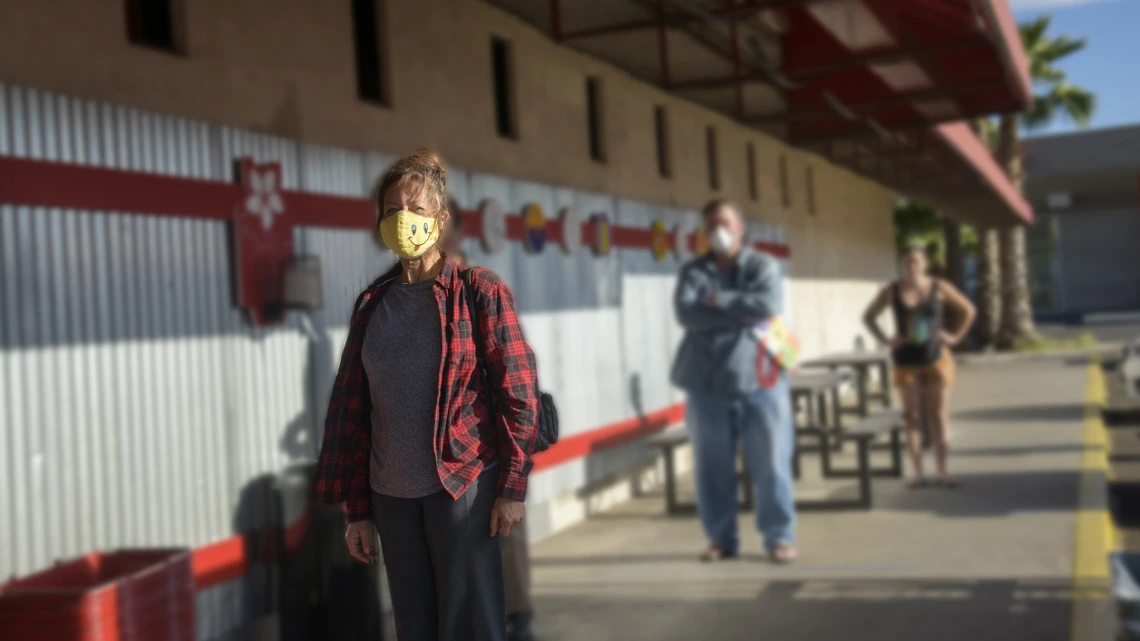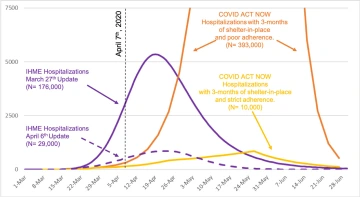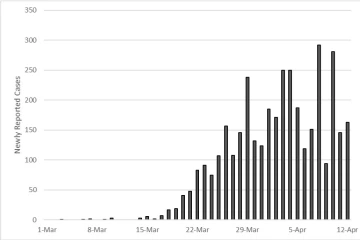UArizona Health Sciences Physician-Researcher Analyzes Data to Inform COVID-19 Public Policy
Reports developed by a Public Health associate professor helped inform Arizona policy makers during the early stages of the COVID-19 pandemic.

Simulation models of COVID-19 spread make future assumptions about human behaviors such as social distancing.
As COVID-19 spread across the U.S. in March, state and local governments faced tough decisions: Should they close schools? Should they issue stay-at-home orders? Should they close non-essential businesses? There were no easy answers, as there wasn’t a lot of reliable data about the novel coronavirus to indicate what the future might hold.

Dr. Joe Gerald analyzed forecast models and developed a series of weekly reports to supply policy makers with important data about COVID-19 and its spread in Arizona.
“I wanted to create something from a public health perspective to compare with current models to see if they were reflecting the reality that we were seeing here in Arizona,” said Dr. Gerald, referring to simulation models produced by groups such as covidactnow.org and the Institute for Health Metrics and Evaluation.
The various simulation models forecasting the spread of COVID-19 arrived at different outcomes based on the human-behavior assumptions: one model assumed people would adhere to social distancing for three months; another forecasted what would happen if residents sheltered in place for three months; and a third looked at the potential effects of a three-month Wuhan, China-style lockdown.
Dr. Gerald took a different route. He used existing raw data on the number of reported cases and deaths from the Arizona Department of Health Services and calculated what the situation might look like if things continued, unchanged.
“I took current events as they have played out and extrapolated into the future, saying that if nothing changes, if no one takes any action, here's what the prior data suggest would be a possible outcome,” Dr. Gerald explained. “It was a rudimentary, purely extrapolation-based report. Its purpose wasn’t to supplant or replace the simulation models. It’s a different perspective that can be produced faster, and one of the advantages is it is based on actual data and not projections.”

Arizona-specific IHME and COVID Act Now simulation results are compared side-by-side in Dr. Gerald’s April 8 report.
On March 30, Governor Doug Ducey issued a “Stay home, Stay healthy, Stay connected” executive order that came “at the recommendation of public health officials who are tracking data specific to Arizona.”
The ability of researchers to provide such data plays a vital role in protecting public health, said Dr. Gerald, who is the director of the Public Health Policy and Management Program at the college. Through the graduate program, students learn about the effective and efficient management of public health programs, as well as policy advocacy, analysis and implementation.
“Writing, interpreting and implementing local, state and national laws are the ways we collectively express our views on how to live our lives, interact with one another and maintain the common good. The job of policy analysts is to advise and inform elected officials and other leaders about specific topics within their area of expertise,” Dr. Gerald said. “Essentially, policy analysts summarize the most critical elements needed to make good decisions and present them to busy decision makers in way that is easily understandable. This allows them to make better informed decisions and promote the general welfare of their constituents.”

A chart from Dr. Gerald’s April 8 report uses Arizona-specific observed data to show the progression of newly reported cases of COVID-19.
Dr. Gerald already has plans to use his experience creating extrapolation reports for the COVID-19 pandemic as teaching material in one of his courses this semester, “Health Care in the U.S.” The undergraduate course is required for all public health majors and has a section that focuses specifically on health policy making.
The Arizona Department of Health Services has put together a COVID-19 task force to advise leaders on how to best respond to the outbreak. The task force includes Dr. Gerald, as well as several other College of Public Health faculty members: Patrick Wightman, PhD, MPP, director of the Center for Population Science and Discovery; Kacey Ernst, PhD, associate professor in the Department of Epidemiology and Biostatistics; Heidi Brown, PhD, MPH, MPhil, associate professor in the Department of Epidemiology and Biostatistics; Kate Ellingson, PhD, assistant professor in the Department of Epidemiology and Biostatistics; Dean Billheimer, PhD, director of the UA Health Sciences and BIO5 Institute Statistics Consulting Laboratory; and Bonnie Lafleur, research professor in the BIO5 Institute; as well as College of Medicine – Tucson faculty members James Knepler, MD, professor of medicine in the Department of Medicine and program director of the Pulmonary and Critical Care Fellowship; and Kathy Hiller, MD, MPH, professor in the Department of Emergency Medicine.

